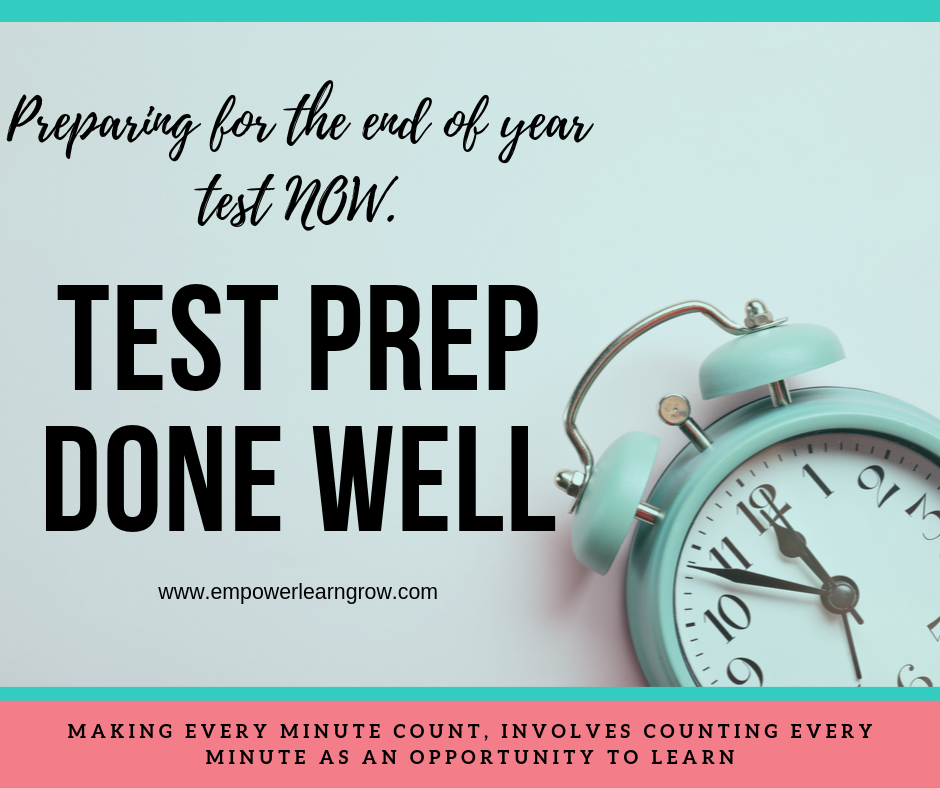
13 Oct Prepping for THE test NOW
Recently, I viewed Simon Sinek’s video on intensity vs. consistency.
He gives the analogy of teeth brushing and the importance of consistency vs. intensity. If you’re like my son, you prefer intensity. The night before the dentist he scrubs his teeth with a renewed sense of passion all in hopes of convincing the dentist he has been brushing his teeth all along.
This analogy reminded me of all we go through to ‘prep’ students for the state test. There is a certain level of urgency right before the test in March or April that turns teachers into ‘crazy brushers.’ We increase the intensity of test prep and do our best to cram as much last-minute content and review into our math lessons as possible. We act desperately, with good intentions, but like my son, with the hope that the last rush of intensity will make up for any ways in which our instruction may have been lacking during the year.
I have been in enough schools to see this test-taking review become an intense focus. We lose instructional time for the sake of review. What we really know, however, is that this instruction or ‘cramming’ is just that—‘cramming’ and will be stored in student’s short term memory instead of in their long term memory where it will actually impact learning in years to come. Laura Slover, CEO of Partnership for the Assessment of Readiness for College and Careers (PARCC), whose exam is the model for Louisiana’s new test, has written that,
“There is no ‘test prep’ for these tests; these are the kinds of test items that require an understanding of concepts and application that only come through a year of effective teaching, not through ‘drill and kill.’”
So, although the cramming may appear to have worked on some level, once disaggregated, the data usually reveals a lack of depth in understanding and at the very least we see those same ‘decent’ scores go down the following year. This, I argue, is because of cramming and information not really learned deeply but rather learned for the moment.
But what are our options? The high stakes associated with state testing have turned us into testing dictators. Not only are our students graded and evaluated on these tests, but so are we.
I’d like to propose consistency over intensity and it begins now. And as Simon Sinek says,
“It’s the little things- over and over.”
Below are two specific ways we can take consistent action that will leave us with intense results. Whether you teach a state testing grade, or you teach in the grades below, I believe these tips would serve anyone in helping students maintain fluency with skills.
Spiral Review.
With most state standards, mastery within a unit is the goal. We spend entire units on fractions in hopes of true mastery over the several weeks it takes to teach that unit. The problem is many students ‘forget’ the content once the unit test ends. I don’t believe they forgot, I just believe they need continual access to the content to build stronger fluency with the topic. It is our job to help keep those concepts fresh.
- Spiral review. Most curriculums will weave in instruction on topics after the units. Even though fractions were taught let’s say in unit 1 and 3, fractions actually show up in classwork and workbooks throughout the subsequent units. This discourages rearranging units so that this review can do as it was intended. This is generally why rearranging units is a bad idea. It also messes up the build in review/spiral of most curriculums.
- Daily review.
- Homework. Many teachers choose to review what has already been taught via homework. Using homework to go over current topics is often frustrating to both students and parents. The topics aren’t understood well enough to practice independently which often causes strife at home. Sending home a spiral review instead, concepts already learned but that need continual reviewal can be a much better option for homework and would result in less cramming before the assessment.
- Transitions: So much time is lost in transitions. Why not use some of this dead time to do a review? Here are some of the transitions I know many have and may not be currently used to the fullest potential:
- Morning or bell transitions: Otherwise known as bell ringers or morning work time. The time when students transition from getting into the classroom to the first subject while the teacher takes attendance or other morning tasks.
- The time between subjects, transitioning to science, PE, Lunch, etc.
- Classroom transitions- like moving from desks to a carpet area and back. Transitioning from desks to get supplies. These are all dead minutes we can use more effectively.
Check out this FREEBIE of ways to use transitions creatively. These ideas don’t have to require a bunch of work and prep. Think ahead just enough to each day or week, add an index card with the skill/skills that were taught that week. Each week add these index cards to a ring, or slide deck. Each week for the transition activities listed on the FREEBIE pull from the ‘RING of REVIEW.’ Being purposeful with this time does require forethought, but it doesn’t have to be very time-consuming. Making these few minutes more intentional, will save you weeks of time come your normal ‘test’ review week that is overall ineffective.
Making every minute count requires us to count every minute as an opportunity to learn.
3.Small group review:
When you decide to be in a review/reteach day, such as after a quiz or unit, or if you do small group stations more regularly, this is a great time to put in your review stations. With each new unit or big idea, you are most likely already building stations to build in practice and fluency. Keep these activities organized in file folders, tubs, etc. so that you can easily rotate them into stations/centers throughout the year. I always have a ‘review’ station that can be done independently by students. Having it cover review subjects on your priority standards is an easy way to keep your review going all year long.
Beef Up Digital Expectations
Teach ways to navigate digital assessments NOW, not the week before the assessment.
Most state tests are now digitized. Students are expected to use the computer to record thinking which involves constructed response, multiple-multiple choice, drag and drop, etc. The format is something many teachers are concerned with as these formats are not practiced all year and they can possibly interfere with scores reflecting computer literacy not student knowledge.
I’ve come to believe this has much to do with what we expect students to do during the year as they take assessments. Whether you are taking unit assessments online (such as through Personal Math Trainer, formatted like state tests), or taking assessments like NWEA MAPS three times a year, students need to treat each of these opportunities like ‘the real deal.’
Have you ever noticed students will show his/her work on paper assessments, but the moment he/she takes the assessment on a computer they do every problem ‘in their head?’ This drives me crazy. All year long they are told to show their work, but the moment a computer is involved, they turn each question into mental math.
Part of this craziness, I believe has to do with what we ‘call’ the paper in which we expect them to show work. My friend, Dave Sawtelle in Colorado Springs, D11 school district, has made it an explicit point to NOT call the paper ‘scratch’ paper.
‘Scratch’ indicates:
If you need it.
Not Important.
Not a ‘real’ part of the test.
Not looked at after the test.
These are the WRONG messages.
So, what if all year long you called the paper something different, like ‘working paper,’ or ‘show me paper?’
What if for EVERY digital session, students had to first fold his/her paper into squares (like 8), and number them? For each number on the assessment, there must be work in that ‘square.’
They know ahead of time you are collecting these pieces of paper and will be using them to help you grade what they know.
This is a double win.
1) Students begin thinking through problems more thoroughly and stop doing so much mental math, resulting in more accurate answers.
2) Teachers get WAY more information on what students know/don’t know.
Once I started moving to more digital assessments, I realized not seeing student work was to my disadvantage. Sure, the grading was easier, but the entire purpose of assessments is for ME to know what STUDENTS know, so I can determine the next steps. Seeing work really helps me to use the computer-generated data to investigate the ‘why’ and the ‘what’ is misunderstood or understood so that I can modify my instruction.
This process also eliminates guessing and ‘luck’ that can take place when we can idly click bubbles and go to ‘next.’
Bottom line: cramming before the assessment is too late. Teaching how to take a digital assessment the week of the assessment is too late. Students need continual review and they need it all year long.
Let’s keep the conversation going. How are you ensuring long term retention of concepts and better results on digital assessments of this knowledge? I’d love to hear your ideas.
Don’t forget to grab your transition freebie via this link:


Sorry, the comment form is closed at this time.